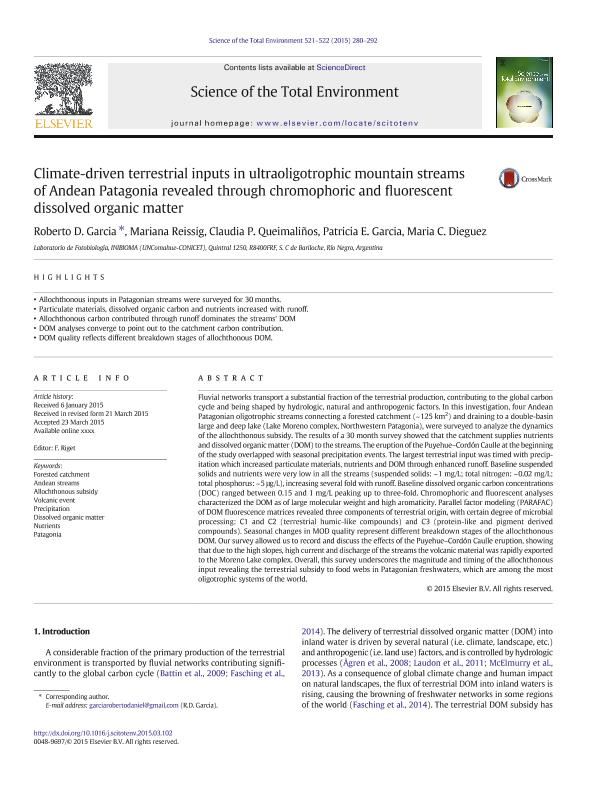Mostrar el registro sencillo del ítem
dc.contributor.author
García, Roberto Daniel

dc.contributor.author
Reissig, Mariana

dc.contributor.author
Queimaliños, Claudia Patricia

dc.contributor.author
Garcia, Patricia Elizabeth

dc.contributor.author
Dieguez, Maria del Carmen

dc.date.available
2017-01-30T20:22:48Z
dc.date.issued
2015-07-15
dc.identifier.citation
García, Roberto Daniel; Reissig, Mariana; Queimaliños, Claudia Patricia; Garcia, Patricia Elizabeth; Dieguez, Maria del Carmen; Climate-driven terrestrial inputs in ultraoligotrophic mountain streams of Andean Patagonia revealed through chromophoric and fluorescent dissolved organic matter; Elsevier Science; Science Of The Total Environment; 521-522; 15-7-2015; 280-292
dc.identifier.issn
0048-9697
dc.identifier.uri
http://hdl.handle.net/11336/12204
dc.description.abstract
Fluvial networks transport a substantial fraction of the terrestrial production, contributing to the global carbon cycle and being shaped by hydrologic, natural and anthropogenic factors. In this investigation, four Andean Patagonian oligotrophic streams connecting a forested catchment (~ 125 km2) and draining to a double-basin large and deep lake (Lake Moreno complex, Northwestern Patagonia), were surveyed to analyze the dynamics of the allochthonous subsidy. The results of a 30 month survey showed that the catchment supplies nutrients and dissolved organic matter (DOM) to the streams. The eruption of the Puyehue–Cordón Caulle at the beginning of the study overlapped with seasonal precipitation events. The largest terrestrial input was timed with precipitation which increased particulate materials, nutrients and DOM through enhanced runoff. Baseline suspended solids and nutrients were very low in all the streams (suspended solids: ~ 1 mg/L; total nitrogen: ~ 0.02 mg/L; total phosphorus: ~ 5 μg/L), increasing several fold with runoff. Baseline dissolved organic carbon concentrations (DOC) ranged between 0.15 and 1 mg/L peaking up to three-fold. Chromophoric and fluorescent analyses characterized the DOM as of large molecular weight and high aromaticity. Parallel factor modeling (PARAFAC) of DOM fluorescence matrices revealed three components of terrestrial origin, with certain degree of microbial processing: C1 and C2 (terrestrial humic-like compounds) and C3 (protein-like and pigment derived compounds). Seasonal changes in MOD quality represent different breakdown stages of the allochthonous DOM. Our survey allowed us to record and discuss the effects of the Puyehue–Cordón Caulle eruption, showing that due to the high slopes, high current and discharge of the streams the volcanic material was rapidly exported to the Moreno Lake complex. Overall, this survey underscores the magnitude and timing of the allochthonous input revealing the terrestrial subsidy to food webs in Patagonian freshwaters, which are among the most oligotrophic systems of the world.
dc.format
application/pdf
dc.language.iso
eng
dc.publisher
Elsevier Science

dc.rights
info:eu-repo/semantics/openAccess
dc.rights.uri
https://creativecommons.org/licenses/by-nc-nd/2.5/ar/
dc.subject
Forested Catchment
dc.subject
Andean Streams
dc.subject
Allochthonous Subsidy
dc.subject
Volcanic Event
dc.subject
Precipitation
dc.subject
Dissolved Organic Matter
dc.subject
Nutrients
dc.subject
Patagonia
dc.subject.classification
Otras Ciencias de la Tierra y relacionadas con el Medio Ambiente

dc.subject.classification
Ciencias de la Tierra y relacionadas con el Medio Ambiente

dc.subject.classification
CIENCIAS NATURALES Y EXACTAS

dc.title
Climate-driven terrestrial inputs in ultraoligotrophic mountain streams of Andean Patagonia revealed through chromophoric and fluorescent dissolved organic matter
dc.type
info:eu-repo/semantics/article
dc.type
info:ar-repo/semantics/artículo
dc.type
info:eu-repo/semantics/publishedVersion
dc.date.updated
2016-12-12T14:29:04Z
dc.journal.volume
521-522
dc.journal.pagination
280-292
dc.journal.pais
Países Bajos

dc.journal.ciudad
Amsterdam
dc.description.fil
Fil: García, Roberto Daniel. Consejo Nacional de Investigaciones Científicas y Técnicas. Centro Científico Tecnológico Patagonia Norte. Instituto de Investigación En Biodiversidad y Medioambiente; Argentina. Universidad Nacional del Comahue. Centro Regional Universitario Bariloche. Laboratorio de Fotobiologia; Argentina
dc.description.fil
Fil: Reissig, Mariana. Consejo Nacional de Investigaciones Científicas y Técnicas. Centro Científico Tecnológico Patagonia Norte. Instituto de Investigación En Biodiversidad y Medioambiente; Argentina. Universidad Nacional del Comahue. Centro Regional Universitario Bariloche. Laboratorio de Fotobiologia; Argentina
dc.description.fil
Fil: Queimaliños, Claudia Patricia. Consejo Nacional de Investigaciones Científicas y Técnicas. Centro Científico Tecnológico Patagonia Norte. Instituto de Investigación En Biodiversidad y Medioambiente; Argentina. Universidad Nacional del Comahue. Centro Regional Universitario Bariloche. Laboratorio de Fotobiologia; Argentina
dc.description.fil
Fil: Garcia, Patricia Elizabeth. Consejo Nacional de Investigaciones Científicas y Técnicas. Centro Científico Tecnológico Patagonia Norte. Instituto de Investigación En Biodiversidad y Medioambiente; Argentina. Universidad Nacional del Comahue. Centro Regional Universitario Bariloche. Laboratorio de Fotobiologia; Argentina
dc.description.fil
Fil: Dieguez, Maria del Carmen. Consejo Nacional de Investigaciones Científicas y Técnicas. Centro Científico Tecnológico Patagonia Norte. Instituto de Investigación En Biodiversidad y Medioambiente; Argentina. Universidad Nacional del Comahue. Centro Regional Universitario Bariloche. Laboratorio de Fotobiologia; Argentina
dc.journal.title
Science Of The Total Environment

dc.relation.alternativeid
info:eu-repo/semantics/altIdentifier/doi/http://dx.doi.org/10.1016/j.scitotenv.2015.03.102
dc.relation.alternativeid
info:eu-repo/semantics/altIdentifier/url/http://www.sciencedirect.com/science/article/pii/S0048969715003770
Archivos asociados
